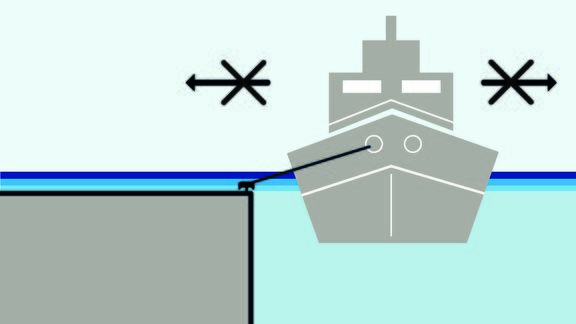Prevent vessels from breaking loose
Heavy winds, waves and high water levels can result in moored vessels breaking loose. Control over the vessels can then be lost, possibly leading to collisions and consequential damage to the vessel and/or to facilities in the port. There are several tried and trusted measures to prevent this.
- Applicable to vessels and mooring facilities;
- Crisis management;
- Temporary measure;
- Substantial investment;
- Prevents economic damage;
- Applicable at all flood depths.

In the event of a wind force 8 or higher, the ‘Storm Regulation’ comes into effect in the port of Rotterdam. This is announced in a Port Information Notice (PIN). The Regulation sets out guidelines relating to incoming vessels. In extreme weather conditions, the Royal Netherlands Meteorological Institute (KNMI) issues hourly weather warnings. The Harbour Coordination Centre of the Harbour Master’s Division informs shipping accordingly. Patrol vessels monitor the safety situation in the port and, if necessary, the Safety Region Rotterdam initiates the GRIP ( Coordinated Regional Incident Response Procedure).In the event of a wind force 8 or higher, the ‘Storm Regulation’ comes into effect in the port of Rotterdam.
The Port Ordinance (Article 3.3) states that vessels must be properly moored and sets out the relevant guidelines. The infrastructure at the terminals, such as bollard capacity and bollard configuration, is designed to accommodate the highest expected loads. However, when there are strong crosswise winds, a vessel’s own mooring lines will not always be strong enough to moor the vessel safely. Additional measures are then required for proper mooring; they are primarily the responsibility of the vessel’s captain.
These measures include, for example:
Taking on ballast water
The total weight of the vessel can be raised with ballast to enhance stability. The surface of the vessel exposed to the wind is then reduced.
Application of ShoreTension
With ShoreTension, you can take a mooring line from the shore to the vessel and maintain the tension with a cylinder so that the vessel is moored better and more securely.
Double lines
You can moor a vessel more securely by doubling the mooring lines on the same bollard or different bollards.
Sending vessels out to sea
In extreme situations, the Harbour Master may decide to send vessels out to sea in good time because they are safer there in very extreme conditions. They can then maintain a favourable course relative to the wind. This measure is rarely used in practice.
Sending vessels inland (to Dordrecht, for example)
If there is enough time when there is a flood threat, you can send ships inland. The storm will have less of an impact in more inland locations, reducing the risks. This approach can be used with a limited category of vessels: inland shipping vessels and small marine vessels in particular.
Mooring vessels on the lee shore
By mooring vessels on a lee shore in good time, you reduce the risk of damage. In this way, vessels are better protected against extreme wind conditions because the load on the mooring lines is reduced. The opposite applies to the effect of waves: vessels are safer on the windward shore.
Tug assistance
It is possible to stop a vessel breaking loose by using one or more tugs to push on the side of the vessel in the direction of the shore.
For more information: Port Information Guide, page 10: “Real time weather and Tidal information”.
Back to the overview.
You can take these measures to improve your flood protection. The focus here is on generic descriptions of the measures in question. If you have questions about applying the measures on your site, please contact the Flood Risk Management Team.
No rights can be derived from the measures. See also the disclaimer.